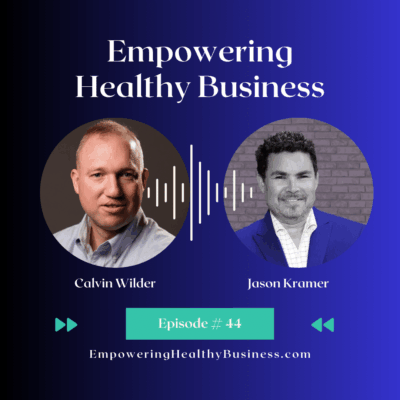Empowering Healthy Business Podcast Episode 44 : How to Use a CRM for Small Business Growth

Running a healthy business means keeping marketing and sales organized, measurable, and effective. That’s hard to do with scattered spreadsheets and one-off emails. In this episode of Empowering Healthy Business, host Calvin Wilder talks with Jason Kramer of Cultivize about practical ways to use a CRM for small business growth—from building a repeatable sales process to tracking which marketing channels actually pay off. This blog turns that conversation into a clear, step-by-step playbook you can use right away.
Why a CRM Matters for Small Business Growth
Sales has changed. Mass “spray and pray” emails no longer work, and busy teams need tools that save time instead of adding more admin work. A good CRM now acts like a virtual sales assistant: it logs activity, surfaces the best leads, and connects your email and website data so you can see who’s really engaged.
Instead of focusing on volume, smart businesses focus on quality. Twenty qualified leads will always outperform a thousand random ones. CRMs also help turn data into insights, so you can spot when a prospect is ready to buy and reach out at the right time.
Build a Repeatable Sales Process
Before you choose a system, you need a process. Many small businesses rely on habit instead of a written playbook. That creates uneven client experiences and missed opportunities. A CRM helps, but only if you know what you want it to support.
Key steps to create a process worth automating:
- Map the first five actions after a new lead arrives (call, discovery, proposal, follow-up, close).
- Define the “next best action” for each stage.
- Standardize messaging with email templates inside the CRM.
- Track core KPIs on a dashboard: new leads, stage conversion, days to close, average deal size.
With this foundation in place, the CRM makes your process faster and more reliable instead of adding noise.
Use Data the Smart Way
One of the biggest strengths of a CRM for small business growth is turning scattered signals into clear priorities. Lead scoring, website tracking, and nurturing campaigns all help sales teams focus on the right opportunities.
Lead scoring assigns points for actions that show intent—like email clicks or form submissions—so sales can prioritize their time. Website tracking links emails to site visits, giving you context for outreach. And nurturing campaigns keep you top of mind with prospects who aren’t ready today but might be in six months. Together, these features help you move from guessing to knowing which prospects are worth your attention.
Tracking Marketing ROI Without Guesswork
Many small businesses spend money on advertising but don’t really know what’s working. A CRM can help you make that measurable.
Ways to track ROI more effectively:
- Use unique QR codes for each offline channel (direct mail, events, signage, print).
- Add specific “How did you hear about us?” options to your forms (yard sign, truck wrap, Facebook, radio, referral, etc.).
- Train staff to ask every caller the same intake question and log answers directly in the CRM.
With consistent data, you can see which channels deliver actual sales and which ones are wasting budget. That makes it easier to cut poor performers and reinvest in the channels that truly work.
Getting Started Without Overwhelm
You don’t need to jump straight into a complex platform to benefit. Many businesses start with spreadsheets, then move to a lightweight CRM as they grow. The key is to move step by step.
A phased approach works best:
- Phase 1: Write your playbook, create templates, and set up a simple dashboard.
- Phase 2: Connect email and website tracking, and turn on lead scoring.
- Phase 3: Build a simple nurture sequence and re-engagement touchpoints.
- Phase 4: Review results monthly and adjust based on data.
By breaking it down, you avoid overwhelm and start seeing results quickly.
Common Pitfalls to Avoid
Even with a CRM in place, some businesses miss out because of poor habits. Skipping playbooks, sending inconsistent messages, or failing to connect sales and marketing often limits results. Others track only clicks and impressions instead of actual deals and revenue.
The fix is simple: write down your process, unify communication with templates, review dashboards monthly, and make sure every marketing dollar is tied to measurable sales activity.
Conclusion: Keep It Simple and Focused
A CRM for small business growth isn’t about buying more software—it’s about clarity. With a light playbook, a few smart automations, and honest reporting, you’ll know where to focus, who to call next, and which marketing efforts are worth the money. Start small, keep it consistent, and let your CRM become the simplest lever for growth.
Want to go deeper? Listen to the full conversation with Jason Kramer of Cultiv on the Empowering Healthy Business Podcast.